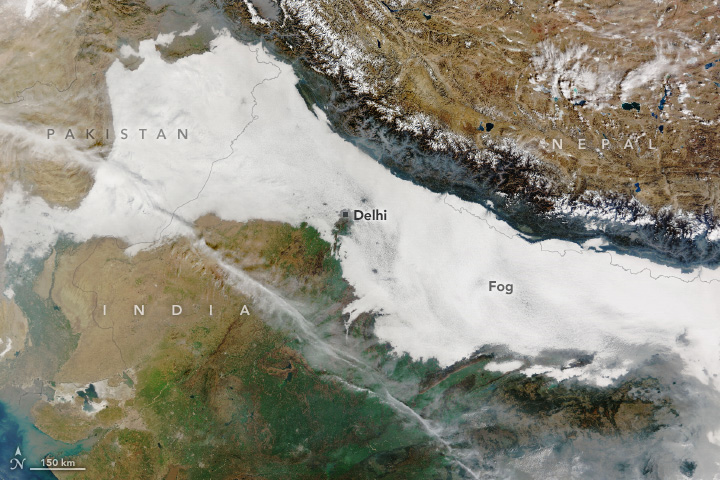Fog Blankets the Indo-Gangetic Plain
Jan 19, 2024
December and January often bring morning fog to the Indo-Gangetic Plain—the flat, fertile lands that span from Pakistan and northern India to Bangladesh. Winter 2023-2024 followed the pattern. From December 24, 2023, through January 18, 2024, large patches of the low, white clouds blanketed the region.
The MODIS (Moderate Resolution Imaging Spectroradiometer) on NASA’s Terra satellite acquired this image on the morning of January 15, 2024, as dense fog stretched from Islamabad, Pakistan, to Dhaka, Bangladesh. Heat islands around some cities—including Delhi, Agra, Meerut, and Rohtak—appear to have punched holes in the fog, revealing the urban landscape below.
Most of the dense fog that occurs in this region is classified as radiation fog. This fog type forms at night when ground temperatures are cool, wind speeds are low, and the air has ample moisture.
Though radiation fog hugs the ground and traces basins, valleys, and bodies of water in ways that appear beautiful and tranquil from above, it can cause chaos for transportation systems on the ground. Fog has caused widespread flight and train delays and cancellations in the region, according to Reuters. One analysis of aviation safety found that fog causes more accidents than any type of weather hazard except for high winds.
Fog also poses a serious risk to drivers, often contributing to spikes in traffic accidents. News outlets in India have reported several fog-related collisions and deaths in recent weeks. Government data from India attributed more than 14,000 traffic deaths and 15,000 serious injuries to fog in 2022, The Times of India reported.
Several teams of scientists, using satellite data, have observed increases in the frequency, persistence, and intensity of fog outbreaks in recent decades across the Indo-Gangetic Plain—trends seen in few other parts of the world. An increase in aerosol pollution associated with urbanization is one potential culprit driving the change, according to one team of researchers from the University of East Anglia and University of Leeds.
Aerosols are small solid particles and liquid droplets emitted into the air by a range of natural and human activities, including the burning of fossil fuels and biomass. Some types of aerosols can amplify fog outbreaks by modifying the microphysics of cloud particles and altering near-surface temperatures and humidity, the researchers reported.
NASA Earth Observatory image by Wanmei Liang, using MODIS data from NASA EOSDIS LANCE and GIBS/Worldview. Story by Adam Voiland.
